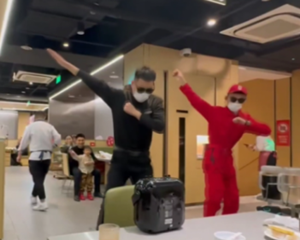What is better than a warming meal of hot pot?
还有什么比享用一顿热腾腾的火锅更好呢?
A catchy dance routine to go with the Chinese cuisine, according to hot pot chain Haidilao.
从火锅连锁品牌海底捞来看,那就是一段动感舞蹈搭配中国美食。
The largest hot pot chain in China has recently started offering a new dance performance as part of the dining experience across its 1,400 branches.
最近,这一中国最大的火锅连锁品牌,在其1400家分店推出了一项新的跳舞表演服务。
Videos of staff springing into the "kemusan" -- or "subject number three" dance -- while guests eat have become the latest internet sensation on Chinese social media.
在中国社交媒体上,工作人员会在顾客用餐时跳起“科目三”舞蹈的视频已经成为最新网络热点。
The routine is widely believed to originate from a wedding dance in the southern Chinese region of Guangxi.
人们普遍认为,该舞蹈源于中国南部广西地区的一种婚礼舞蹈。

The dance involves performers swinging their knees sideways as they perform a snappy series of hand actions, including rapid-fire wrist-twisting moves.
这种舞蹈需要表演者一边侧摆膝盖,一边做出一系列快速的手部动作--其中包括快速的扭腕动作。
To "unlock" the new service, diners have to utter the code word "kemusan" to the servers, according to anecdotes posted online.
根据网上的说法,要“解锁”这项新服务,顾客必须对服务员说出“科目三”这一暗号。
In videos posted on social media, some diners seem to enjoy it so much that they join staff in the performance.
在社交媒体上发布的视频中,有些顾客似乎非常喜欢这种表演,甚至会和工作人员一起跳。
Not everyone finds the Haidilao dancing cute. The act has started a debate online, with some calling it a "low" promotional tactic.
不过并非所有人都觉得海底捞的舞蹈很讨喜。这一行为在网上引发了争论,一些人认为它是一种“低俗”的营销手段。
The company did not comment on reports that some branches have stopped offering the dance in the wake of the recent debate.
有报道称,在最近的争议之后,部分海底捞门店已停止提供这种舞蹈服务,但海底捞公司对此未予置评。



